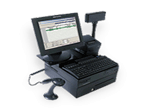
Organizations that are lacking a POS system are losing money by the day. A POS system is essentially a cash register with a difference. It is a computerized system designed to bring order to a business and has the ability to dramatically cut down on wastage while increasing profits. The basic equipment involved in a POS system includes a monitor, a cash drawer, a receipt printer and of course, a computer. It should be noted that POS systems are not ‘one size fits all’ solutions to a business. Retailers and restaurants have very different needs which is why they need POS systems with varying features.
Reduces Inventory Shrinkage
Did you known that American stores lose almost 2% of their stock through inventory shrinkage each year? Inventory shrinkage is defined as stock that disappears from the store due to external theft and employees taking their own ‘bonus’ at the end of their shift. 2% may not sound a lot but it equals a total loss of well over $30 billion a year in American stores. Effectively if $300,000 worth of stock enters your store each year, almost $6,000 is lost through shrinkage. That’s a lot of money. Even worse, approximately 48% of this shrinkage is due to employee theft. POS systems accurately track inventory, meaning that any losses will quickly be uncovered. Watch as your store sees a magical reduction in its shrinkage!
About 15% of shrinkage comes due to administrative error which essentially means employees entering the wrong code which leads to products being sold at the wrong price. With a POS system, your employees will never make another price error again. Also, it is possible to change all prices in seconds with the POS system. Gone are the days of laboriously changing prices with pricing guns and annoying stickers.
The detailed sales reports provided by POS systems enable you to discover the items that are selling well and those that are underperforming. This means changes in the location of products can be implemented quickly and easily. This could take the form of placing a low-selling product in a more prominent position in a retailers or promoting a dish that is selling poorly in a restaurant.
Knowledge Is Profit
All of the above are instances of POS systems providing you with more information. It will be able to give you a complete overview of your entire sales, including how much of a particular item sold that week. This is important because American retailers and restaurants are guilty of an appalling amount of wastage every year. It is estimated that almost $20 billion worth of food is disposed of by stores in the United States each year. This is approximately 8% of perishable goods purchased. Using our $300,000 stock example, that’s $24,000 worth of food wasted in a year. Can your business afford to waste that level of produce? Aside from the ethical questions raised by the waste of good food, it is poor business practice.
The giant retailer, Stop & Shop, used an innovative scheme to lower their level of wastage in 2006. With the aid of their sophisticated POS system, Stop & Shop changed their entire methodology. This included reducing the size of their fresh food packages as well as limiting the number of products on display. This store realized they were overstocking certain items thanks to their POS system. As a result, wastage was cut by over 30% which saved them approximately $50 million a year. Although your company’s revenue is probably a drop in the ocean compared to Stop & Shop, the principle is still the same.
Know Thy Customer
The fact that most American stores simply don’t know their customers is another key reason why there is so much wastage. With a POS system, you will have the ability to start collecting data on your customers. Knowledge of your customer’s buying pattern will help you determine your inventory. For example, there may be certain products bought during a particular season. Launching a targeted marketing campaign is another reason to collect information about your customers. Millions of dollars are wasted each year by companies who have no idea how to market properly. With targeted advertising, you will spend less money and receive better results. You can also commence incentive programs to entice extra customers to your store.
A POS system generally retails at between $2,000-$6,000 though huge corporations will have sophisticated machinery worth tens of thousands. If this seems like a large investment, bear in mind that at least 10% of your stock is lost through inventory shrinkage and waste. Therefore, a store that makes a profit of $60,000 a year could almost recoup the cost of the POS system within 12 months as it should cut wastage and shrinkage to minimal levels. This does not even take into account the improved efficiency which will equal better service and an increase in custom. A POS system will dramatically improvement an organization’s profit margin and is worth its weight in gold.
